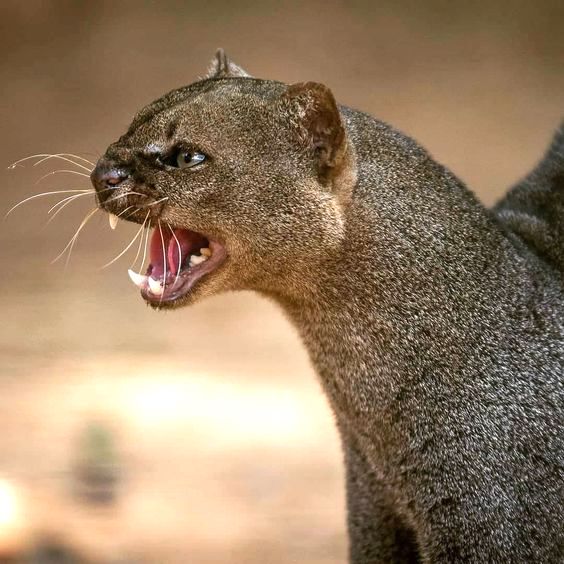The Jaguarundi range is marked in purple on the maps below. They are copies of the IUCN Red List map or and accurately prepared map based on the IUCN Red List of Threatened Species™ map which is probably the most up to date map. But all maps of wild cat ranges need constant improvement and updating as the initial information is sometimes less than perfect and things are changing all the time. Feel free, therefore, to upgrade the map if you have the knowledge and are willing!

Update January 11, 2022: when I first created this map about 13 years ago or so, it was my intention for other people to become involved to amend the map and gradually update it as the years went by. The distribution of the wild cat species needs, as mentioned, updating. But sadly, nobody got involved and on one occasion a person deleted one of my maps. It was the distribution of the puma which was removed by a nasty person. Therefore, I have removed that option.
Maps (4) showing jaguarundi distribution as at 2022
Also, I have updated the distribution not via the Google map but through a screenshot of the map is provided by the Red List which as you can see is dated December 2019 which is quite recent. There was talk about the jaguarundi being in Florida and Arizona. Officially it is found in neither state.
View Jaguarundi Geographic Range in a larger map
At 2002, the Jaguarundi range (distribution) extended from Southern Texas (no longer it seems as the last one was killed by road traffic in 1986 apparently) through to southern Mexico, central America and into South America where it occupies a vast and significant percentage of this continent. They prefer lowlands up to about 2000 metres above sea level, but have been seen at about 3,200 metres above sea level (Columbia). They occupy a wide variety of habitats.
The Jaguarundi’s range overlaps with (is “sympatric”) the ocelot, margay and oncilla but they prefer more open areas than these other small wild cats. Radio tagged cats in Belize were found to prefer areas near streams. The video embedded in the map above of a Jaguarundi swimming across a stream in Suriname indicates their ease in dealing with water and that they hunt in and around water. There is a report of a Jaguarundi catching fish in a pond. They are opportunistic hunters taking what they can.

In Belize and Mexico studies showed that the Jaguarundi hunts in the daytime, with the peak time for hunting being late morning. In Venezuela a study found that mammals make up the biggest part of this cat’s diet but that birds and reptiles also formed a large part of the diet.

As is the case with other wild cats and domestic cats the Jaguarundi eats grass. This is thought to be a dietary supplement for cats that aids the production of hemoglobin through folic acid in the grass (Cat Eating Grass – opens a new window).
From Jaguarundi Cat to Wild Cat Species. See some pictures of the Jaguarundi.




Hi Don, I have just noticed that my Google Map does include a sighting in Texas. There you go.
Thanks, Don, for taking the time to write an interesting and valuable contribution to the page. What I’ll do is review the page in the light of what you have said.
From 1979 through December of 1982 I was a Biological technician with the USFWS. I just read your blog about the Juguarundi. I saw no mention of this species being found in Texas. Did not mention that I was employed at the San Bernard NWR. I became very interested in this species as I observed small cat tracks in slough crossing on several occasions. Two colleagues thought that they were domestic cat tracks. I disagreed because we were miles from the nearest human habitation. The abundance of coyotes, in my opinion would have made short work of any feral house cats. One day while driving along the refuge road, just past the crossing where I observed these tracks I saw up ahead Two small felines, the luck of a hard wind in my favor and driving a vehicle with a standard transmission, I put transmission in neutral shut off engine and coasted. I was very close to them before they were aware I was there. I stopped, ran toward them as fast as I could, hoping they would tree. They did. Only problem, I didn’t have the camera. Man who did was at the other unit miles away, so I couldn’t raise him on the radio. I made all the observations I could. They were I estimated 20 to 25 feet up. They were somewhat larger then a house cat but longer and more slender. Tail was much longer. And the represented two of the color morphs of the species. I had read all I could find on this species. Solitary, seldom seen in pairs or groups except at mating and female with young. Farther research revealed it was mating season. I had a second sighting about a month later of a single animal. Never got photo documentation. I transferred to the Valentine NWR sometime later. My new position included refuge law enforcement. I attended the FLETC at Glencoe GA. In service training included a week of in-service training at a federal facility near Tucson AR. We got to spend one day off.. I went to the desert museum where I knew they had captive Juguarundi. As soon as I saw the captive animal. There was no doubt that what I saw years before were Juguarundis in the wild.